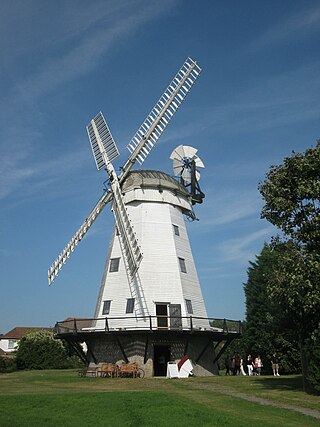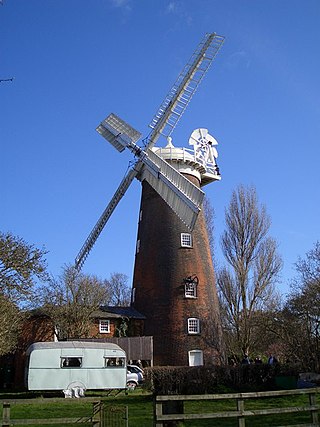
Upminster Windmill is a Grade II* listed smock mill located in Upminster in the London Borough of Havering, England. It was formerly known as Abraham's Mill and was in Essex when built. Between 2016 and 2023 the mill was restored to working order and a visitor centre was constructed. The mill and visitor centre are open to the public at selected times.

Outwood Windmill is a Grade I listed post mill in Outwood, Surrey. Built in 1665 by Thomas Budgen, a miller from Nutfield in Surrey, it is Britain's oldest working windmill. It was one of a pair after 1797, alongside a smock mill that had the tallest smock tower in the United Kingdom until its collapse in 1960.

Union Mill is a Grade I listed smock mill in Cranbrook, Kent, England, which has been restored to working order. It is the tallest smock mill in the United Kingdom.

Charing Windmill is a Grade II listed smock windmill, now converted to a house, on Charing Hill in Kent in southeast England. It is sometimes known as Field Mill, but that name was also used by a watermill in Charing.

Herne Windmill is a Grade I listed smock mill in Herne, Kent, England, that was built in 1789.

Draper's Windmill or Old Mill is a Grade II listed Smock mill in Margate, Kent, England that was built in 1845.

Killick's Mill is a Grade II* listed smock mill in Meopham, Kent, England that was built in 1801 and which has been restored.

Sarre Windmill is a Grade II listed smock mill in Sarre, Kent, England, that was built in 1820. Formerly restored and working commercially, the mill is now closed.

Davison's Mill, also known as Stelling Minnis Windmill, is a Grade I listed smock mill in Stelling Minnis, Kent, England that was built in 1866. It was the last windmill working commercially in Kent when it closed in the autumn of 1970.

Lower Mill is a smock mill in Woodchurch, Kent, England that was built in 1820. It was a Scheduled Ancient Monument from 1976 to 1978, and remains a Grade II* listed building.

Blackdown Mill or Cherry Clack Mill is a grade II listed smock mill at Punnetts Town, East Sussex, England, which has been restored.

Shiremark Mill, also known as Kingsfold Mill or Capel Mill was a listed Smock mill at Capel, Surrey, England, which was burnt down in 1972.

Baker Street Mill is a grade II listed smock mill at Baker Street, Orsett, Essex, England which has been part adapted to residential use on its lower two floors only.

Terling Windmill is a grade II listed Smock mill at Terling, Essex, England, which has been converted to residential use.

South Ockendon Windmill was a Smock mill at South Ockendon, Essex, England which collapsed on 2 November 1977.
Church End Mill is a grade II listed Tower mill at Great Dunmow, Essex, England which has been converted to residential use.

Messing Maypole Mill is a grade II listed Tower mill at Tiptree, Essex, England which has been converted to a residence. Prior to boundary changes made when the civil parish of Tiptree was established in 1934, the mill was in the parish of Tolleshunt Knights.

Gainsford End Mill is a grade II listed tower mill at Gainsford End, near Toppesfield, Essex, England, which has been converted to a residence.

Buttrum's Mill or Trott's Mill is a Grade II* listed tower mill at Woodbridge, Suffolk, England, which has been restored to working order.
Mill Lane Mill is a Grade II listed tower mill at Carbrooke, Norfolk, England which has been conserved with some machinery remaining.

















